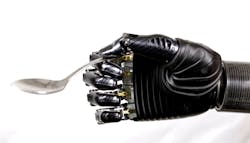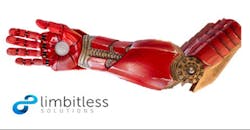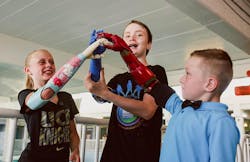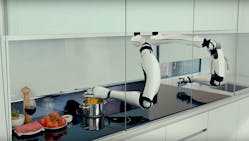A lot of stuff in the fictional Star Wars universe is pretty sketchy from a certain point of view -- science's. We may never shoot lightning from our hands or blow up planets with a single shot, but robot hands similar to Luke Skywalker's may very well be a reality in the next few years, thanks to advances in mechatronics and sensors. And the thing that binds it all together is not midi-chlorians, but 3D printing.
In the past few years, there has been an explosion of activity in the 3D-printed prosthetic space, as it's the most cost effective and fastest way to prototype complex components. Because of that, it’s also a life-changing innovation for kids who need a prosthetic, but previously couldn't afford one.
One of the newest visionaries in the field is a 28-year-old engineering Ph.D. named Albert Manero, the president of Limbitless Solutions. His non-profit operating out of Orlando was put on the map when Robert Downey, Jr. appeared in a YouTube video to give a boy named Alex some Stark Industries Iron Man tech, actually a prosthetic lower right arm. The organization recently moved into a new lab on the campus of the University of Central Florida, and Manero spoke with us recently to talk about the 3D printing industry and how his work could be shaping the future.
NED: How did you get started making 3D-printed prosthetics?
It's been an incredible example of being interrupted by a passion that I didn't know was there. Since middle school, I wanted to go into aerospace engineering to build space planes. Along the way, at the University of Central Florida, where I earned by bachelor's, master's and doctorate, I met a local family asking about building their son a bionic arm. They were inspired by Ivan Owen, who created the [first 3D-printed] e-NABLE hand. So we went to work on that. From the reception around the world, it was so clear that there were so many people in need and I didn’t know that that. So we formed our non-profit in the hopes of being able to make an impact for the kids without limbs and make it so their families really didn't have to pay or be financially burdened.
NED: And in 2014, that first kid, Alex, was in the viral video with Robert Downey, Jr. How did that happen?
The Microsoft Collective Project picked us as one of three student-led innovation projects. They showed Robert Downey Jr. a video we had made with a Transformers-inspired arm to gauge his interest. He was really excited by it and really passionate about what we were doing and agreed to help lend a hand.
NED:The most noticeable feature on all your limbs, not just Alex's, is the colorful customization on each one. Besides being cool, what's the rationale for that?
So we know the rejection rates for kids with traditional plastic prosthetics is quite high and from listening to kids that we've talked to the biggest difference is that it becomes part of their personality. The dull plastic prosthetics felt like an apology to everyone else that the kids were broken. And we tried to flip that on its head.
When the kids start to identify with their arm, they get a matching cell phone case or dress. It's no longer an apology that they were born different. It's just part of who they are and that's really empowering for kids. I think that empowerment makes them more likely to want to use it.
NED:So how does it make you feel when you get to see like Alex hanging out with Robert Downey Jr. or are the other kids who you know try on the prosthetic for the first time what's that feel like for you seeing that?
That's definitely the moment for us. We recently had three or four kids gather and seeing them interact with one another and be able to amplify each other's energy. This really is what makes our team work so hard.
NED:What do you think this use case says about where 3D printing is?
3D printing is great for customization, but it's not a silver bullet. You use different manufacturing techniques when they're appropriate. But definitely for rapid prototyping and iterations and customization of the complex art, 3D printing was so valuable because it let us explore and create and then redesign parts that were light and structurally sound and that can actually be used.
NED: And how did you learn about 3D printing?
I went to a brand new engineering academy for high school in the Tampa area. At the time, there was a little learning curve and I explored the classic downfalls of 3D printing and support material and small interior cavities or pipes that tend to be more difficult to print. That helped me know what works and what vulnerability points of the technology were. Having that in high school, part of the Project Lead the Way curriculum, was so valuable because when I got to college I knew what it could do, I knew how to use it, and when I got presented with this type of project, I knew I could just go to the lab here and be comfortable with the machine.
NED: What can you tell us about your new lab?
We have a mix of about 20 students, from freshmen to graduate students, working with the newer model of the Stratasys Dimension. We do post processing with chemical treatment after the parts come out and increase strength and resilience. We're working with our students to make parts that thread together and have fasteners that have mechanical vantage points like springs and motors. And that's kind of a different way to teach how to use 3D printers. We're trying to integrate the hardware with electronics. We're also training them in mechatronics so they're learning PCB design and electronic assembly as well as dimension and sculpting base CAD tech technologies software. And I think that that's going to lead as it progresses into a really well equipped group of students that can think about these different things so we try to give them some of the biotech mind while giving them that design and engineering skills.
NED: And how do you think this new batch will use these hybrid skills?
The hope is that every student we're working with is going to take what they're learning here and then be able to use it for a problem that they run into or discover. And so we really hope that it will provide a great background for them to go innovate and be able to change the world.
NED: More and more companies are coming out with very lifelike robotic hands for use in kitchens and in factories. Have you started to work with industrial partners to take this tech into the plant?
We're just kind of at the beginning now that we have our facility open here and these conversations seem to be happening every week so I hope it comes through.
For more information or to inquire about partnerships with Limbitless Solutions, please email [email protected].














